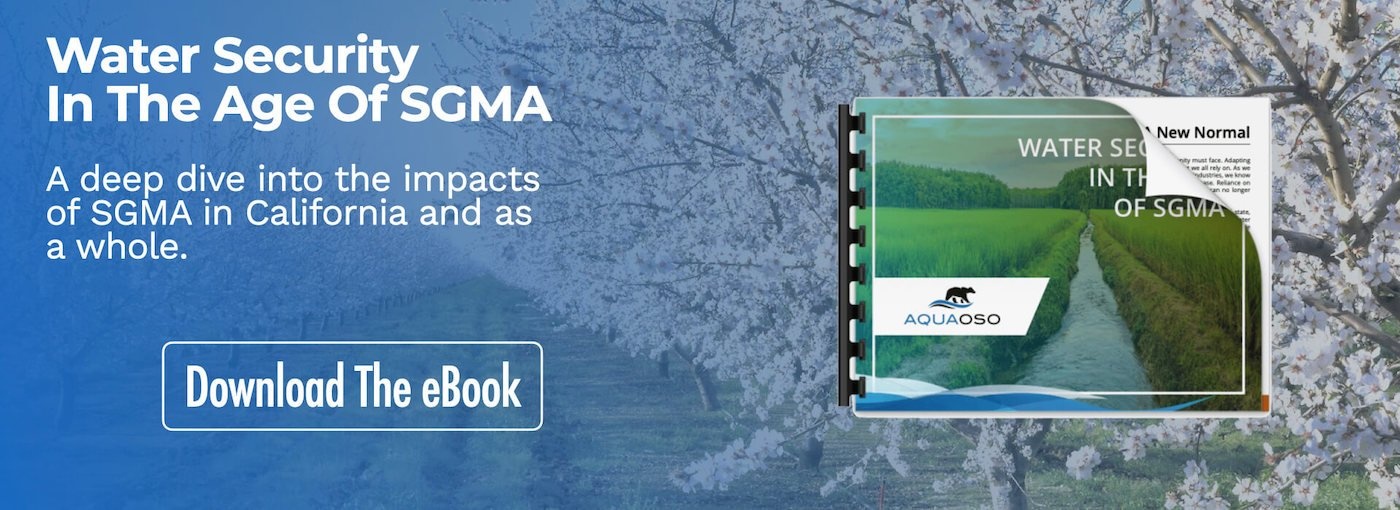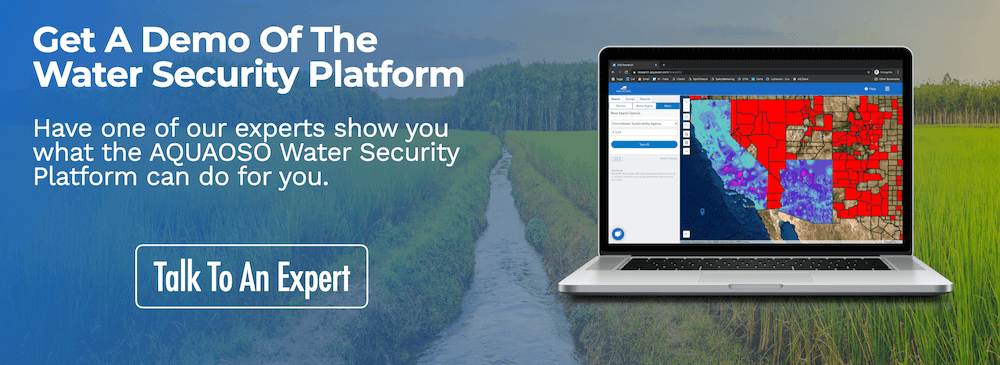The Future of Water Scarcity in Agriculture for Lenders and Investors

Part of our How to Conserve Water in Agriculture Guide
Water availability has a direct impact on the productivity of agriculture. The scarcity of water represents a real risk for all players in the Ag market. One of the ways we like to look at water in terms of the food supply chain is to think about it as a raw material that goes into the production (growing) of food.
“Global water use has increased by a factor of six over the past 100 years and continues to grow steadily at a rate of about 1% per year”
United Nations World Water Development Report 2020
Around the world water use has continued to steadily increase, yet water availability has begun to decrease. This is leading towards a future of increased water scarcity in agriculture.
Farmers will experience this change first hand by needing to implement more water recycling, better trading and banking, smart water markets and efficient infrastructure to maintain the same water access. These new demands are costly and require serious time investments, yet do not guarantee they will fix the issue.
We expect to see agricultural productivity in many parts of the world begin to decline (or at least be limited by water availability by season). Which will lead to farms being unsustainable and possibly shutting down. Eventually, farmers may need to default on loans and there will be an overall reduced number of farm owners. Understanding water scarcity is integral in managing these risks and protecting investments in agricultural land and businesses.
Regions of High Water Scarcity
Unsurprisingly, in the United States, the regions with the highest density of agriculture are also the areas with the most productive lands. A map created by Bill Rankin, using information from the United States Department of Agriculture (USDA), shows California, Illinois, and Indiana as three states with the most profitable farms.
A recent report by Black Rock Investment Institute, entitled Troubled Waters, found some alarming results. It estimates that by 2030 a large portion of California, Illinois, and Indiana will have medium to high rates of water stress. This means these regions will have a higher demand for water than what is available.
These states are just a few of the areas that will see water stress increase. Blackrock projects there will be increased water stress throughout the United States and the world. Many other fertile farming regions will be hit hard.
It is clear water is becoming a more limited resource. Access to water will likely be a limiting factor on the number of agricultural activities an area can sustain and/or the crops it can sustain (think almonds in California — consuming 40 gallons per almond). Furthermore, it is likely that policy changes will divert some water away from agricultural lands to supply commercial and residential properties. Instead of more farms being developed in areas with consistent returns, farms may actually be shutting down or be forced to go idle. This will be especially prevalent in many areas of California in the era of SGMA because of the large push to recharge the aquifers.
For agricultural investors, this might translate to fewer loan requests and higher risk loans. Having an understanding of water resources will be even more important when assessing long term financial outcomes.
Water Scarcity in Agriculture – Trends Across the Industry
Without even considering future water stress, many farmers already struggle to make a living from their farms. A study done by the USDA and other federal agencies found that farms producing less than $350,000 worth of goods per year struggle to meet the U.S. median income.
Additionally, current production rates show:
- 50% of farms have sales of less than $10,000 per year, which accounts for 1% of the total national agricultural production in the U.S.
- 4% of farms have sales of more than $1,000,000, which accounts for 66% of the total national agricultural production in the U.S.
Clearly, even though there are much fewer large-scale industrial farms, they produce the majority of agricultural products in the United States. This trend will likely continue in the future as production costs increase with the changing environment.
Many farmers in the $10,000 or less range supplement their profits by non-agricultural means. In some cases, this translates to people eventually leaving the agricultural industry altogether. Currently, only 2% of the United States’ workforce is in agriculture, compared to 70% in 1840. While this transition can’t be completely blamed on economic hardship (and is more indicative of macro-production shifts), but it definitely plays a part.
As water stress grows in the coming decades we will see this trend continue. Many smaller farms simply won’t have the capacity to deal with the challenges that arise. Additionally, it may not be in their financial interest to spend capital on improving water efficiency when the returns are so low.
While in many situations closing shop might be the best financial choice, it will not always be the case. Some farmers, whether they don’t have other revenue streams or their families have cultivated the land for generations, will want to continue to stay in agriculture. To meet the water changes that are occurring they will need to make investments in their land.
You will play a pivotal role in helping these farmers stay in business with your understanding of water scarcity risks. Access to reliable loans at reasonable rates is one of the only ways small-scale farmers can adapt to the increasing water scarcity in agriculture.
Water Infrastructure Costs
Even though this looks like a bleak future for the agricultural industry there is a double-sided sword that could be seen as positive for ag as a whole in the near term. The world’s population is increasing, so demand will continue to grow. The World Bank estimates that agricultural production will need to expand by 70% before 2050 to meet this demand. Risk is increasing in the agricultural industry, yet it will need to continue to expand.
This will likely be achieved through larger-scale farms that have more tolerance for risk and have the capital to invest in water efficiency measures.
“The World Bank estimates that global water infrastructure costs are expected to rise fourfold to $150 billion annually from 2017 levels by 2030.”
This infrastructure will focus on sustainably managing and using the limited water resources that are available. A few of these key projects are increasing irrigation efficiency, strategically locating farms near water sources, and harnessing services to understand water scarcity in the immediate area.
Understanding water scarcity issues can reduce your risk exposure from these investments. Additionally, it gives you the opportunity to capitalize on the substantial investment Ag businesses will need to make in the coming years.
Black Rock puts it best, “Companies that manage water resources better than their peers may offer more resilient earnings streams.”
The coming decades represent a pivotal time for the agriculture industry. We will see a large investment in infrastructure and a shift towards larger farms, which represents an opportunity. By successfully managing and understanding water scarcity issues in your region you can make knowledgeable investment decisions.
Read more about how to conserve water in agriculture and why it matters to you financially in our guide.
The Bottom Line
Having this knowledge will put you in a position to manage new water regulations that are introduced. For example, the Sustainable Groundwater Management Act (SGMA) in California has redefined the way California will assess the maximum amount of groundwater that can be withdrawn. AQUAOSO partnered with ASFMRA to produce a free water map to assist communities in identifying and monitoring their water risks. This map was made with the same tools available to AQUAOSO subscribers.
To learn more about AQUAOSO, or request a demo, don’t hesitate to Get in Touch.


